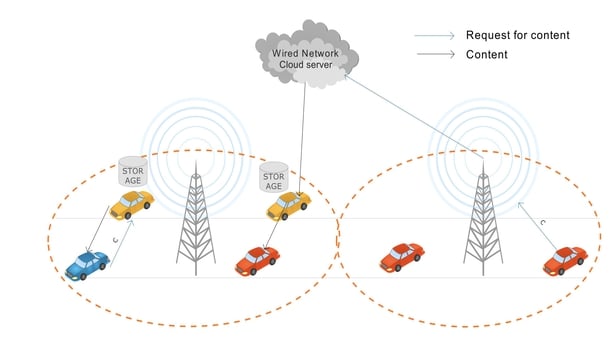Are connected cars the future of transportation?
Analysis: Connected vehicles would allow for the fast and efficient exchange of data about traffic, weather, parking and other issues
By Sangita Dhara, TCD
These days, we are used to staying connected. We expect information and entertainment to be readily available to us if we are at home or at the office or commuting. It could be real-time updates on traffic congestion and alternative routes during our commute or information on nearby tourist attractions during a holiday.
But during peak traffic hours, the demand for information from commuters can overwhelm traditional networks. Similarly, when driving in areas with spotty cellular reception, live streaming can be disrupted.
Content-Centric Networking for vehicles is a solution for these issues. Instead of relying on central servers, this looks for updates and information ‘near me’. It can obtain data from any nearby vehicle that has the required information, making the process faster and more efficient. Vehicles share information with each other, creating an on-the-road library for any kind of content that may be in demand.
From Bloomberg Technology, Ed Ludlow reports on the future of connected cars
This can make any journey more enjoyable through suitable infotainment, without suffering from the drawbacks of more traditional networks. When traveling, this network acts as your personal tour guide. Your car connects with other cars in the area to gather content about nearby attractions, historical sites, traffic and weather updates. You receive updates from other vehicles that have recently visited the area such as recommendations on places to visit, food to enjoy, must-have experiences and even hidden gems.
Vehicular Content-Centric Networking (VCCN) allows vehicles and roadside units to build a library of frequently requested data locally, reducing the need to repeatedly contact the actual data source. This, in turn, reduces network congestion. It also allows you to request data by name and receive it based on location or name-wise dissemination.
Need traffic updates? Looking for your GPS coordinates? Want real-time temperature data or weather updates? The data is then forwarded and retrieved either from the original source or from a nearby collection of information stored as part of the VCCN.

In this example, the red vehicle initiates a content request. If the content is not available from a local car, the request is forwarded to the cloud server or the original producer. Then, the content is transmitted back to the yellow vehicle through the base station and delivered to the initial requester, the red vehicle. Meanwhile, the yellow vehicle stores the content for future use. Upon a subsequent request from the blue vehicle, the stored content is retrieved once again from the yellow vehicle, without needing to get it from the cloud.
Vehicular Content-Centric Networking offers a glimpse into the future of connected vehicles. By leveraging a smarter content delivery system, it could transform our in-car experiences, making them safer, more informative and more engaging. The system is still evolving and improvements in content storing and forwarding techniques are key.
Various factors are considered when deciding what information to store:
Popularity: Frequently requested data is more likely to be stored. For example, information on free parking slots can be popular.
Lifetime: Data with a short lifespan is less likely to be stored – ie information on those free parking slots or a traffic incident is valid only for a short period.
Availability: A vehicle might store the latest weather forecast, as it may not be available from other sources while the vehicle is moving
We need your consent to load this YouTube contentWe use YouTube to manage extra content that can set cookies on your device and collect data about your activity. Please review their details and accept them to load the content.Manage Preferences
From US Department of Transportation, connected vehicles and the future of transportation
One idea is to store information based on the category of information (Emergency, Traffic, Infotainment, Education) likely to be popular in the area the vehicle is currently in and based on the vehicle’s predicted future route. This can be done by considering factors like the popularity of data in the past, the time of day, the day of the week, the vehicle’s current location, its destination and its route.
A vehicle driving through a tourist area, for example, might store information about tourist attractions, hotels and restaurants, but a vehicle in a city centre might store information about traffic conditions, parking availability and public transportation routes. On a motorway, a vehicle might store information about traffic conditions and rest stops.
By enhancing vehicle communication through advanced data retrieval, innovative content storing techniques and strategic interest forwarding, we can improve the performance of VCCN and user experience. This will make driving safer and more enjoyable, offering a glimpse into the future of connected vehicles.
Follow RTÉ Brainstorm on WhatsApp and Instagram for more stories and updates
Dr Sangita Dhara is a Research Fellow at the School of Computer Science and Statistics and the CONNECT Science Foundation Ireland Research Centre for Future Networks and Communications at TCD.
The views expressed here are those of the author and do not represent or reflect the views of RTÉ

